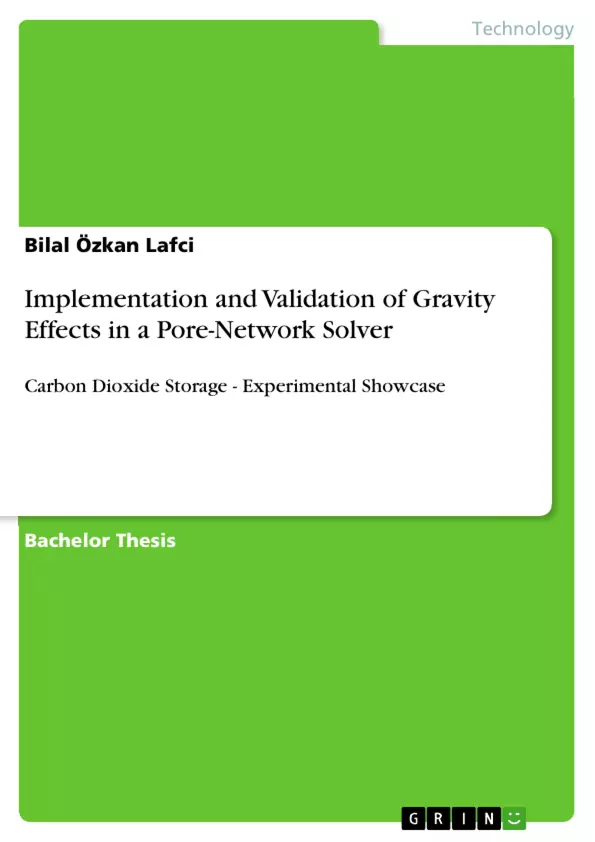Inhaltsverzeichnis (Table of Contents)
- 1 Introduction
- 2 Pore network solver with gravity
- 2.1 Physical displacement mechanism
- 2.2 Local capillary pressure pr(s) (Lee et al. [2009])
- 2.3 Gravity affected flow rate between pore bodies.
- 2.4 Mathematical Equations and algorithm.
- 2.4.1 ASSUMPTIONS
- 2.4.2 BOUNDARY CONDITIONS
- 2.4.3 GOVERNING EQUATIONS.
- 2.4.4 PRESSURE FIELD SOLVER
- 2.4.5 TIME-STEP CALCULATION
- 2.4.6 ALGORITHM
- 3 Validation and code development
- 3.1 Test Case 1 Macroscale pore column (single phase)
- 3.2 Test Case 2 - Microscale pore column (single phase & low interfacial tensions)
- 3.3 Test Case 3 - Microscale pore column (single phase & high interfacial tensions)
- 3.4 Test Case 4 Macroscale pore column (multiphase)
- 3.5 Test Case 5 - Microscale pore column (multiphase & low interfacial tension)
- 3.6 Test Case 6 - Microscale pore column (multiphase & high interfacial tension)
- 3.7 Test Case 7 & 8 - Microscale pore column with injection of less dense fluid.
- 3.8 Test Case 9 - 2D-Pore field with equal sized pore bodies (low interfacial tension)
- 3.9 Test Case 10 - 2D-Pore field with equal sized pore bodies (high interfacial tension)
- 3.10 Test Case 11 - 2D-Pore field with poly sized pore bodies (low interfacial tensions)
- 3.11 Test Case 12 - 2D-Pore field with poly sized pore bodies (high interfacial tensions)
- 4 Parameter study on fluid displacement
- 4.1 Drainage Phase-diagram for immiscible displacement after Lenormand et al. [1988]
- 4.2 Influence of Interfacial Tension
- 4.3 Influence of the viscosity ratio
- 4.4 Influence of inlet pressure and injection rate
- 4.4.1 Displacement evolution
- 4.4.2 Influence of flow rate variations
- 5 Simulation of the CCS-Showcase
- 5.1 Experimental setup.
- 5.2 Pore network modeling of CCS-Showcase.
- 5.2.1 HYPON-model after Acharya et al.
- 5.2.2 Assumptions for the pore network
- 5.2.3 Generation of the pore network
- 5.3 Simulation of the experiments
- 5.3.1 Physical properties of injected fluids
- 5.3.2 Ethyl acetate with a flow rate of 150 ml/min and 2mm glass beads
- 5.3.3 Heptane with a flow rate of 150 ml/min and 2mm glass beads
- 5.3.4 Comparison of ethyl acetate and heptane
- 5.4 Simulation of a High Pressure Showcase
Zielsetzung und Themenschwerpunkte (Objectives and Key Themes)
This Bachelor thesis aims to simulate and analyze the mechanism of fluid displacement in porous media, specifically focusing on the injection of ethyl acetate and heptane into a water and glass bead-filled CCS-showcase, which is an experimental setup to understand carbon dioxide storage processes. The main objectives include:- Implementing gravity effects into a pressure solver to simulate fluid displacement.
- Validating the approach through a series of test cases, progressively increasing in complexity.
- Conducting a parameter study to investigate the influence of capillary, gravity, and viscous forces on fluid displacement.
- Simulating the CCS-showcase using the HYPON pore network model.
- Comparing the simulation results with experimental data to assess the accuracy of the model.
Zusammenfassung der Kapitel (Chapter Summaries)
The thesis starts with an introduction to the global energy challenge and the importance of carbon capture and storage (CCS) technologies. The CCS-showcase and its experimental setup are presented, highlighting the need for simulations to complement experimental analysis.
Chapter 2 delves into the pore network solver with gravity, explaining the physical displacement mechanism and the implementation of gravity effects on the flow rate and capillary pressure. Mathematical equations, boundary conditions, and the algorithm are presented in detail.
Chapter 3 focuses on validation and code development, presenting a series of test cases designed to evaluate the accuracy of the gravity-implemented pressure solver. The test cases range from simple single-phase pore columns to more complex multiphase systems and 2D-pore fields.
Chapter 4 analyzes the parameter study on fluid displacement, examining the influence of factors such as interfacial tension, viscosity ratio, and inlet pressure on the spreading behavior of nonwetting fluids.
Chapter 5 describes the simulation of the CCS-showcase using the HYPON pore network model. This chapter covers the modeling of the showcase, the generation of the pore network, and the simulation of experiments using ethyl acetate and heptane.
Schlüsselwörter (Keywords)
The main keywords and topics of this thesis include: carbon capture and storage (CCS), pore network modeling, gravity effects, capillary pressure, fluid displacement, interfacial tension, viscosity ratio, HYPON model, CCS-showcase, ethyl acetate, heptane, simulation, validation. These terms represent the core focus areas of this work, encompassing both the theoretical aspects of fluid displacement in porous media and the practical application of these principles to the simulation of real-world scenarios, such as the CCS-showcase.- Quote paper
- Bilal Özkan Lafci (Author), 2012, Implementation and Validation of Gravity Effects in a Pore-Network Solver, Munich, GRIN Verlag, https://www.grin.com/document/276760



